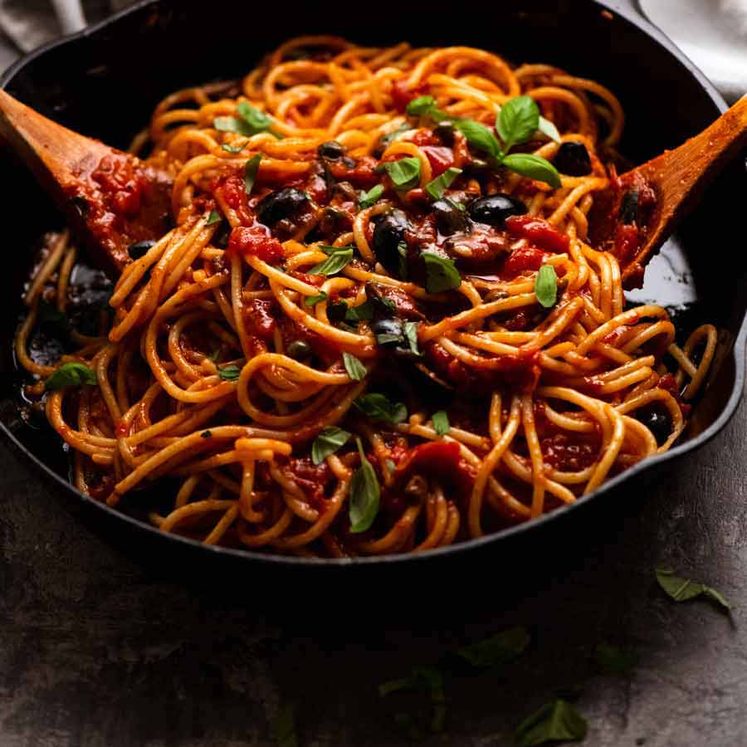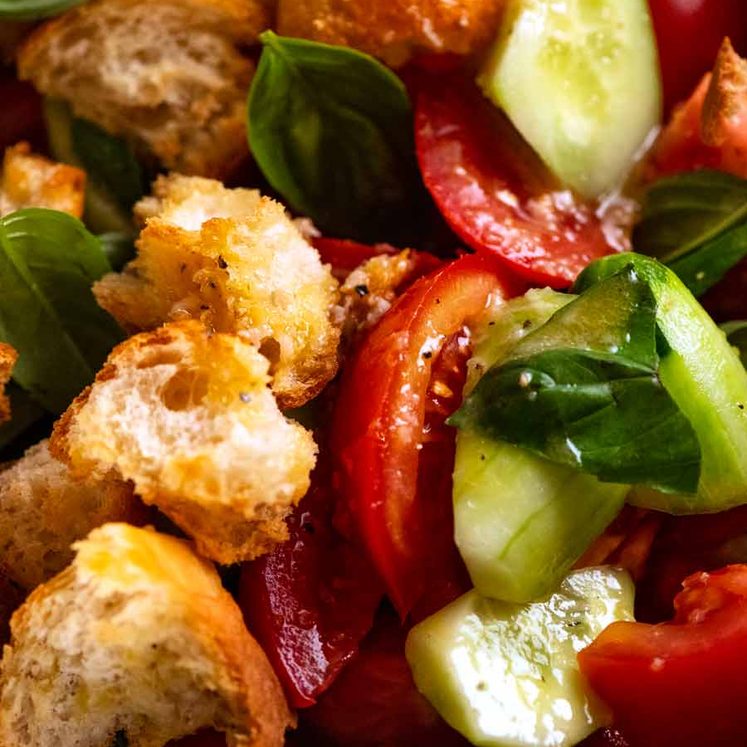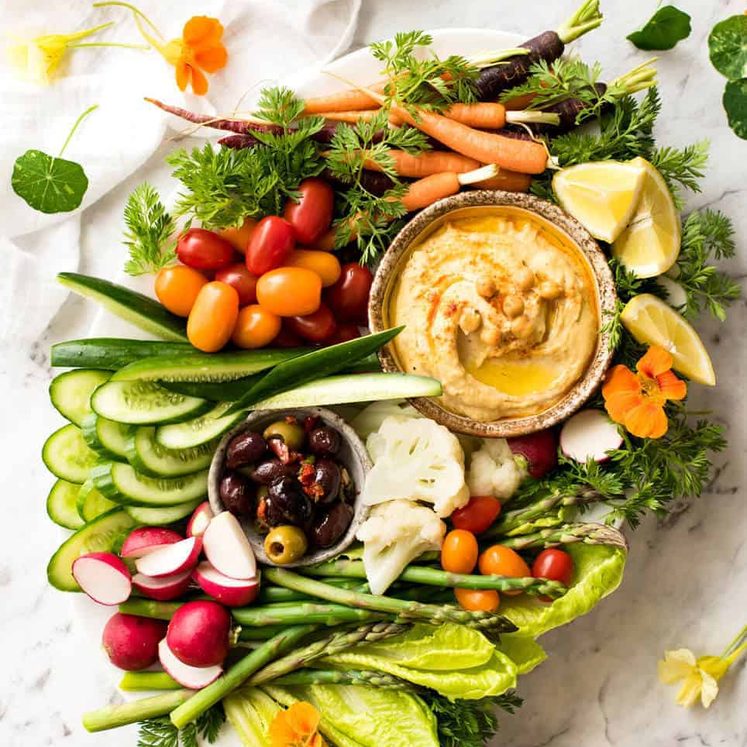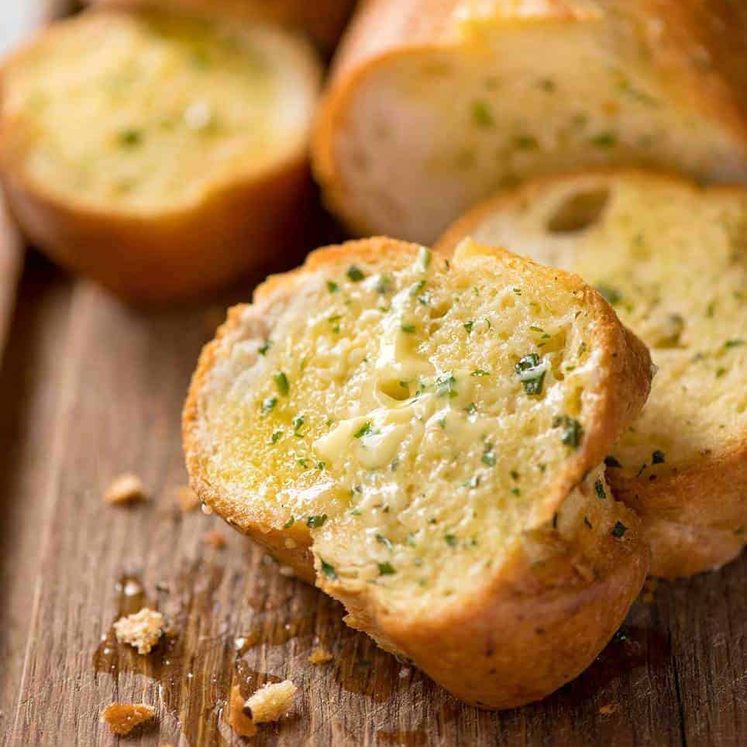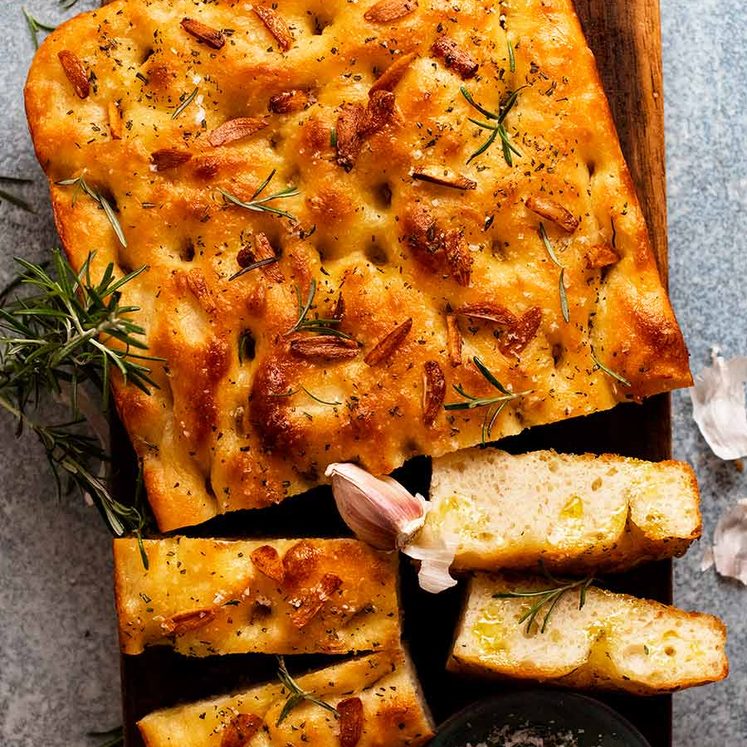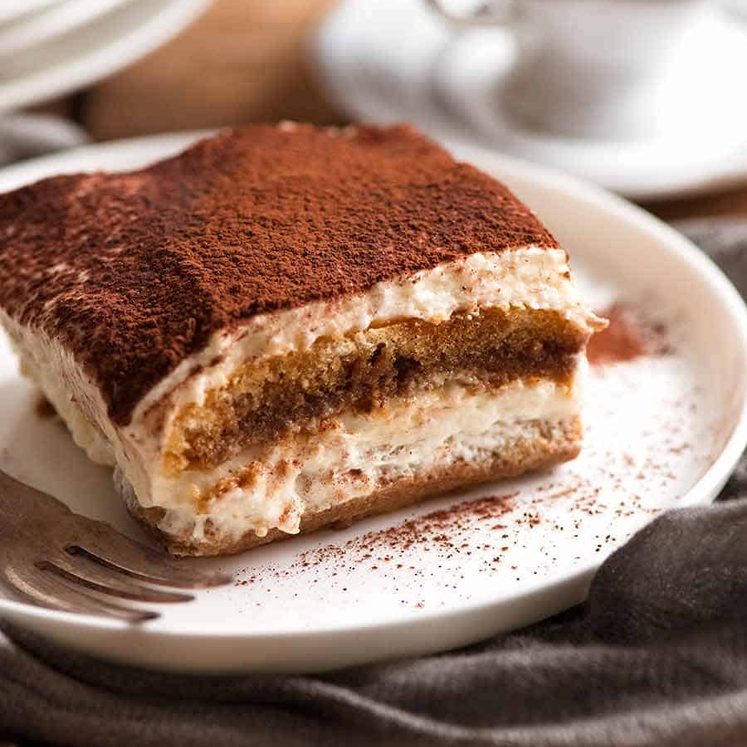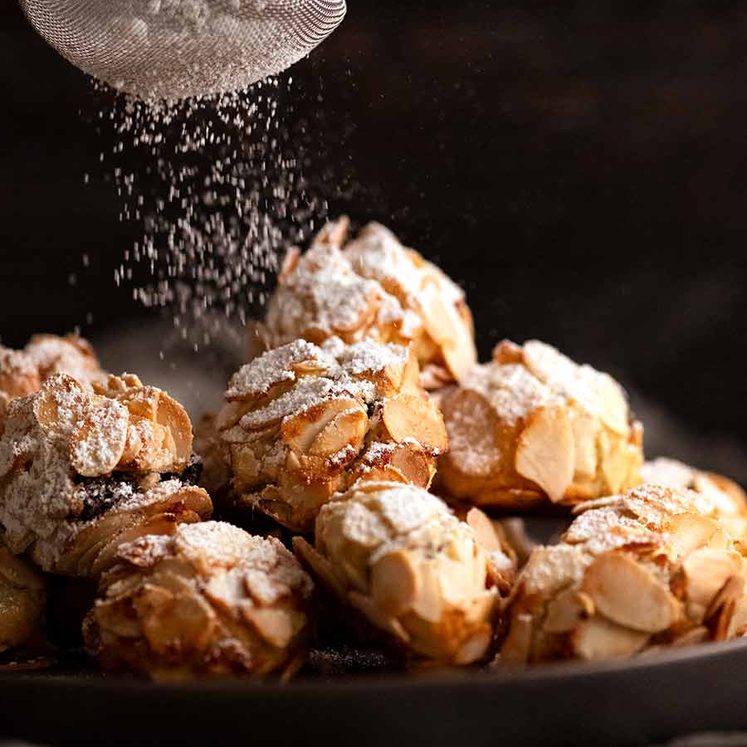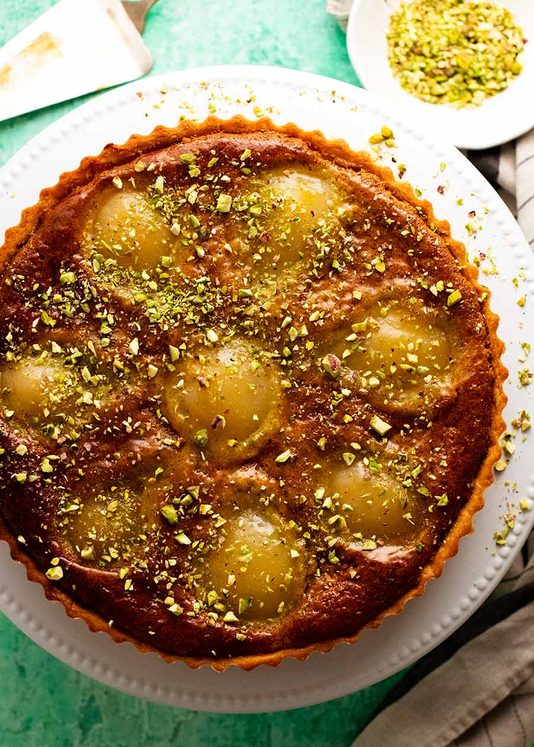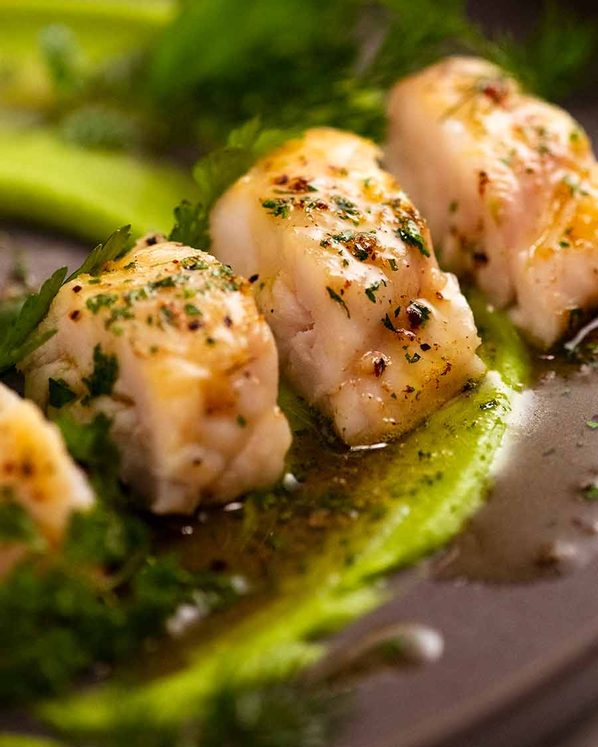Spaghetti alla Puttanesca is a traditional Italian pasta from Naples that’s quick to put together from pantry staples. If you have canned tomatoes, garlic, olives, anchovies and capers in your cupboard, you can knock out this simple but flavourful sauce in a flash. It’s a stellar emergency meal everyone should know, with a “saucy” backstory of its own!
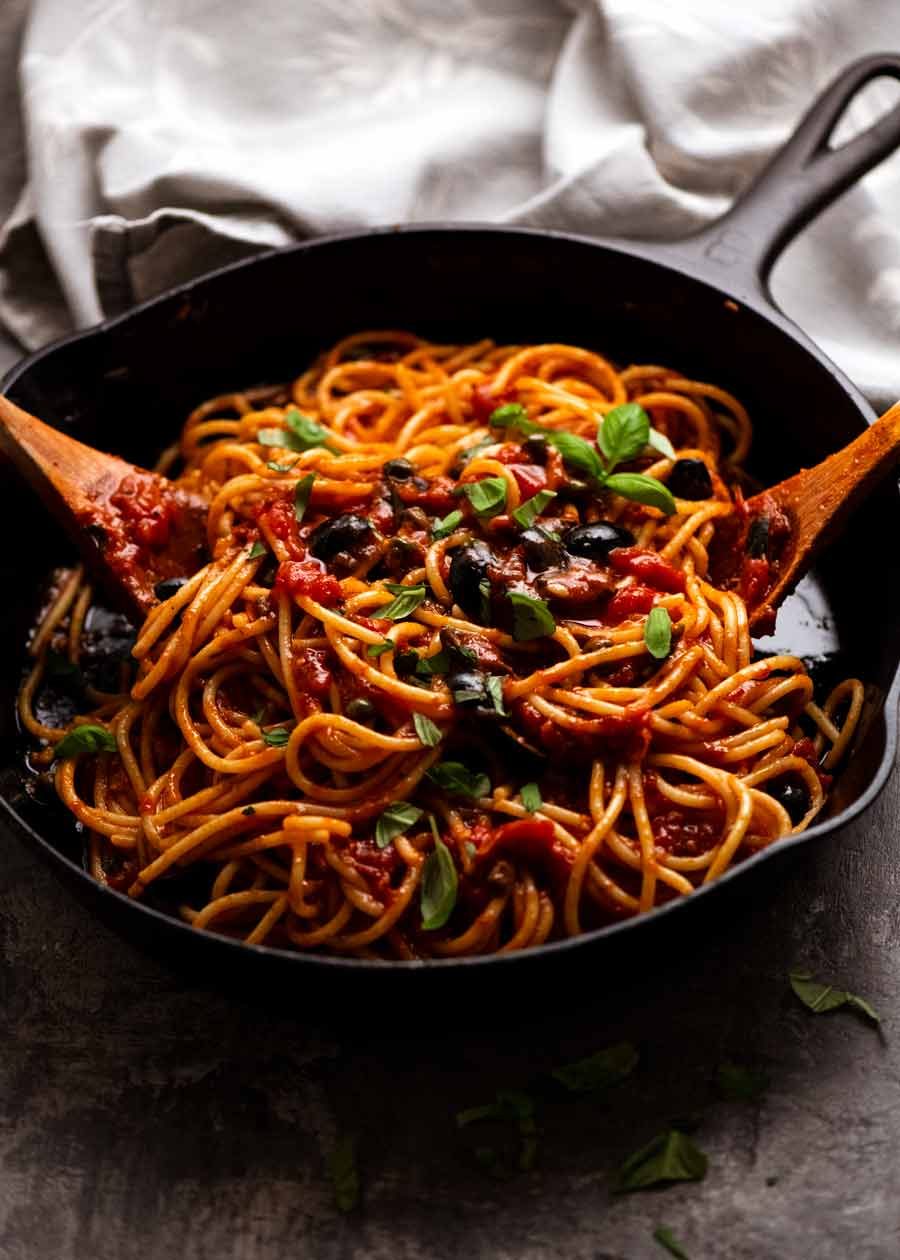
Spaghetti alla Puttanesca
There are various colourful stories explaining how this dish came to be, and how Puttanesca pasta got its name. “Puttanesca” roughly translates to “working girls” in Italian (that’s a politically correct term I’m using there!) One tale tells how this dish was invented in the brothels of Naples so the smells wafting from the kitchen would entice potential … errr, clients. Another story claims this pasta was a quick and simple dish ladies of the Neapolitan night could throw together in a hurry in amongst their busy schedules.
Does this kind of talk on a G-rated food blog make you blush? 😉
Whatever the origins, today this is considered a classic and staple Italian pasta recipe. It’s budget-friendly, easy and quick to make, yet delicious enough to woo family and friends (or indeed, “paying customers” … 😉)
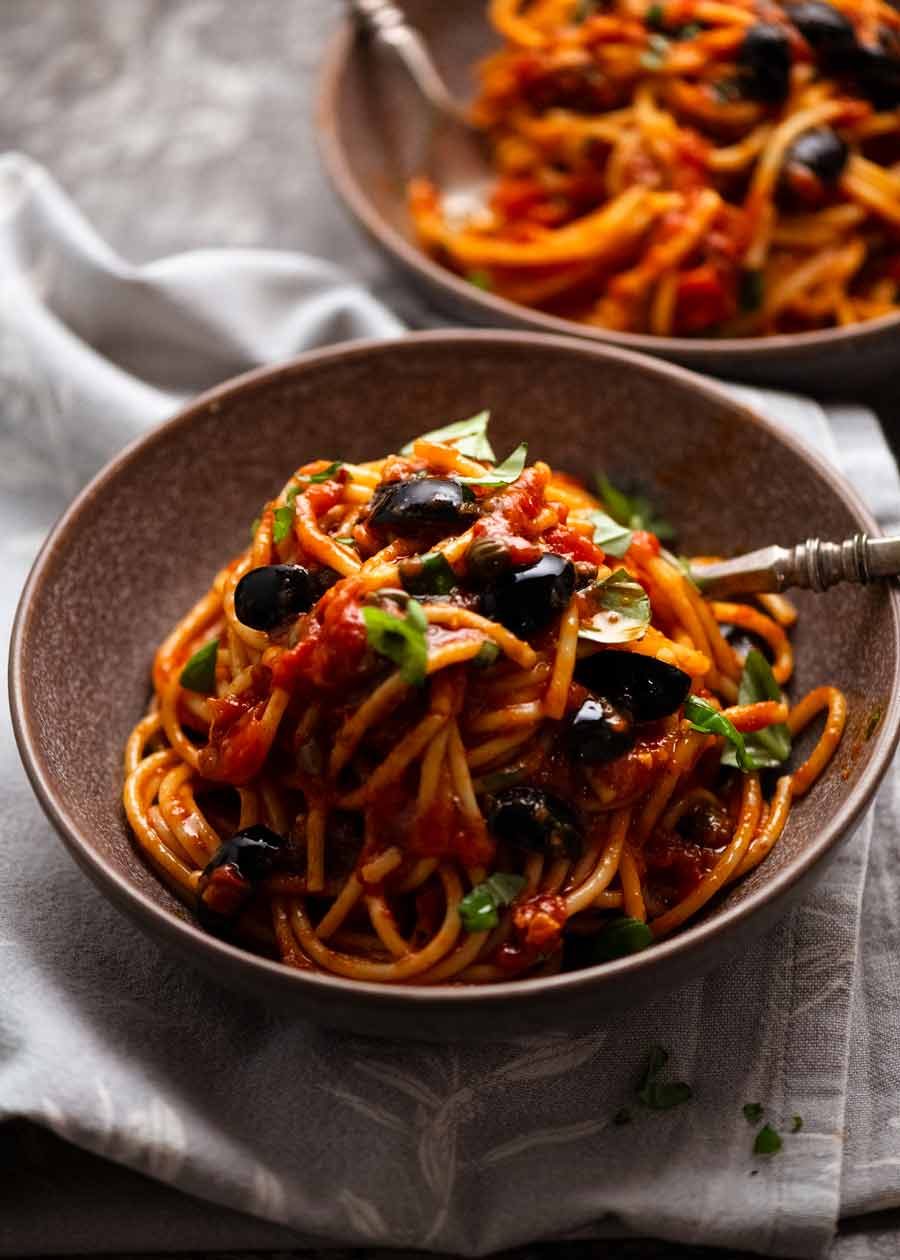
Ingredients in Puttanesca sauce
Being such simple recipe, this is one of those dishes that genuinely benefits from better quality ingredients. In this pasta, the one ingredient I find is really worth seeking out is fresh deli-style olives in olive oil or brine, rather than cheaper jarred ones you find on supermarket shelves.
Oh, also, anchovies – the secret “why is this simple sauce so good?” ingredient. If you skip it, the sauce isn’t quite as good! However you can leave it out if you wish to make the dish vegetarian / vegan (add a little more garlic, capers and olives instead).
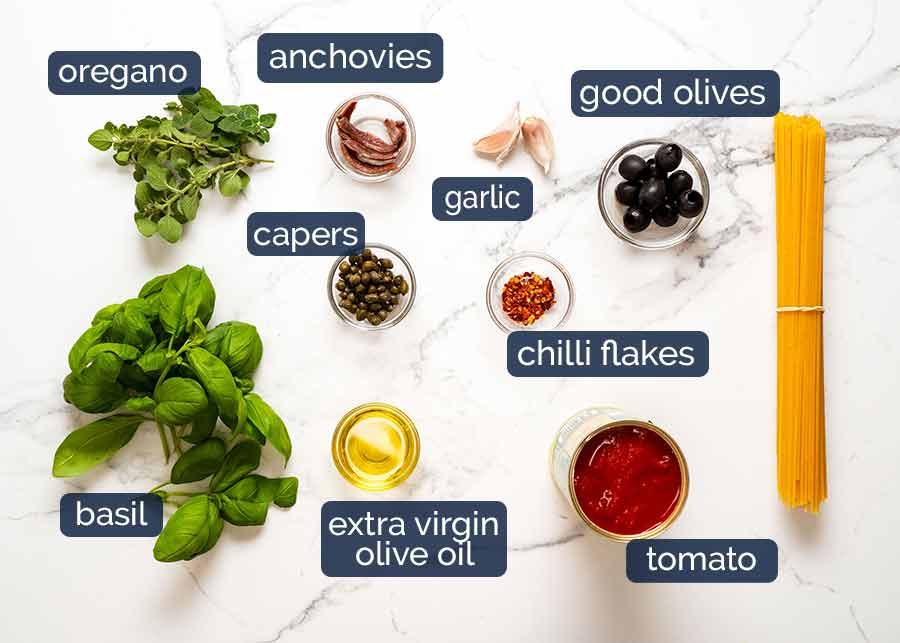
-
Black olives – Try to use good quality, fresh olives from the deli. These come in either olive oil or brine and will add more flavour into the sauce as it simmers compared to bottled ones that come in sealed jars. Both pitted and unpitted are fine but pitting your own is best.
-
Anchovies – This adds savoury flavour and salt to the sauce without leaving it “fishy-tasting”. In fact, you’d have to have a highly attuned palate to be able to taste it at all. The anchovies are finely chopped and dissolve into the sauce, and any strong fishiness disappears leaving just deliciously deep umami.
I prefer to use whole anchovies and finely mince it myself because it has better flavour than using anchovy paste. But paste is a handy alternative – my rule of thumb is 1/4 teaspoon of paste per anchovy (so use 3/4 teaspoon in this recipe).
-
Spaghetti – Traditionally made with spaghetti or vermicelli pasta (ie. the thinner spaghetti), though this recipe works just fine with any long pasta. Or short, for that matter!
-
Tomatoes – Not all canned tomatoes are created equal! Better ones are sweeter and break down better to create a sauce.
TIP: If you find your tomatoes are a bit on the sour side, just add a touch of sugar to the sauce. It’s a cheat’s way of taking the sour edge off that is a game changer with for example, Spaghetti Bolognese.
-
Capers – Adds little pops of briny goodness and that unique caper flavour to the sauce. I usually use standard size capers. On occasion, I find they can be giant in size so I’ll reach for the baby capers instead. Both work!
-
Garlic – Because this is Italian food!
-
Chilli flakes (aka red pepper flakes) – A pinch of heat is wonderful in this sauce. It’s not a spicy sauce, here it’s just a background hum of warmth.
-
Extra virgin olive oil – For cooking and finishing.
-
Fresh basil and oregano – These finishing herb touches will really lift the dish and return some freshness to the sauce. But if you don’t have them, it is absolutely still worth making using a pinch of dried oregano. Don’t bother with dried basil, it’s basically flavourless.
If you don’t have basil, serve with a sprinkle of parmesan instead. The extra flavour will compensate for absence of fresh herb flavour.
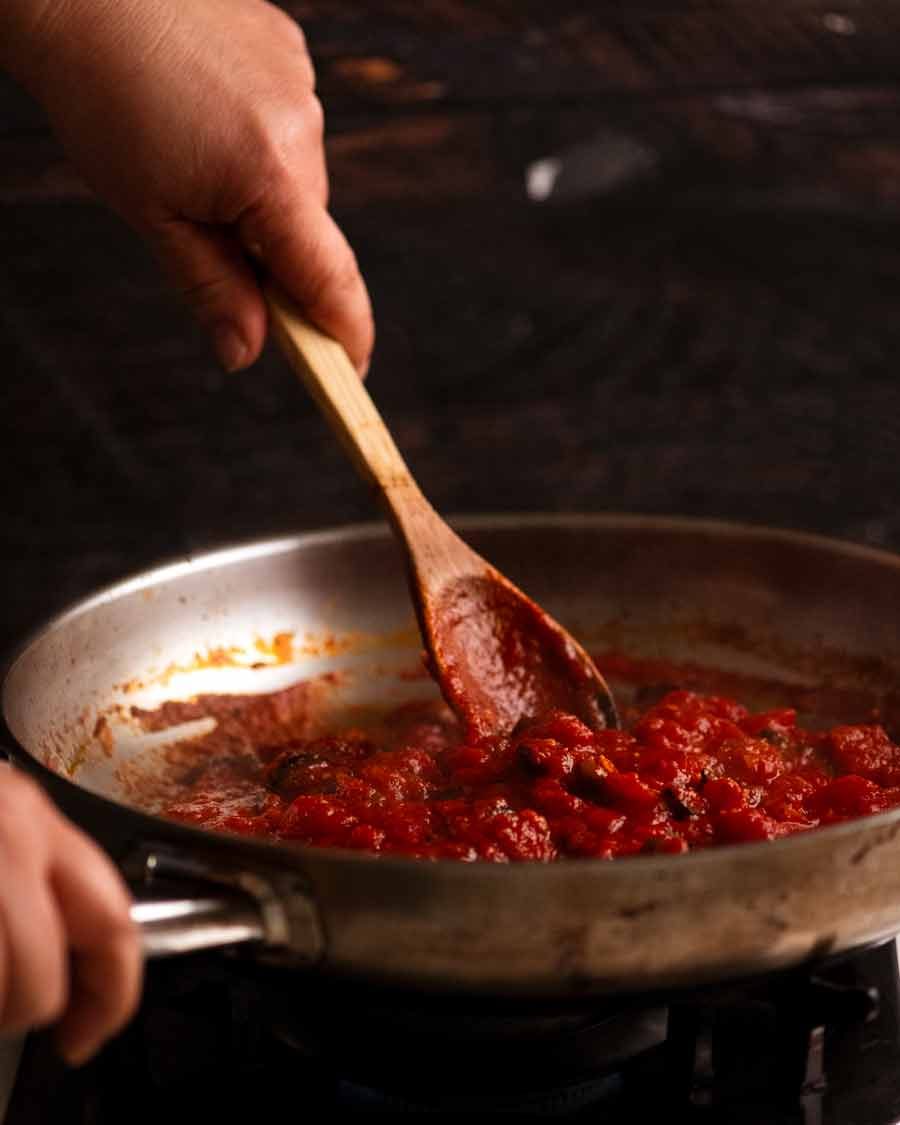
How to make Spaghetti alla Puttanesca
Start the sauce first and get it simmering, then cook the pasta. They’ll both finish at the same time, ready to toss together!
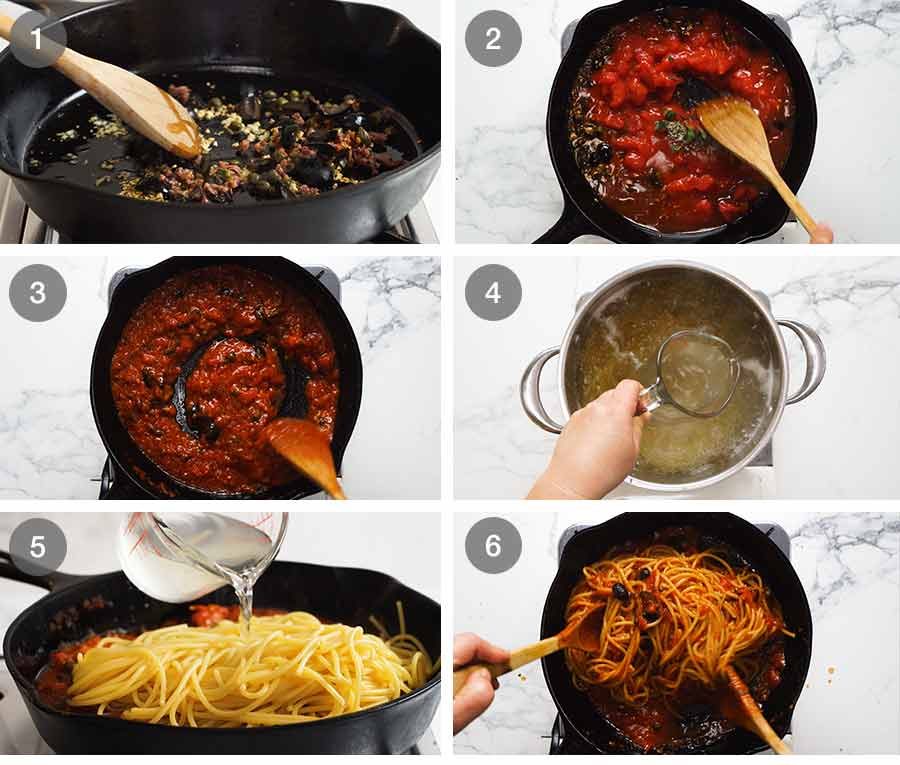
This recipe serves 2. Use a medium size skillet here rather than a very large one, else the sauce will dry out too quickly when simmering. If you’re scaling the recipe up however a large skillet will be necessary to toss the pasta in the sauce (or use a pot for the sauce and tossing).
-
Sauté aromatics – Start off by sautéing the garlic in olive oil until it starts to go golden on the edges. Then add the finely chopped anchovies, capers, olives and red pepper flakes and cook for a further 1 minute.
This sautéing step is key to the flavour of the sauce. It blooms the flavour of the red pepper flakes and even more importantly, takes the raw fishy edge off the anchovies while causing them to break down, ready to dissolve into the sauce.
-
Add everything else into sauce – Add the can of tomatoes, then add water by rinsing out the can. In goes salt, pepper and fresh or dried oregano, then give it a good stir.
-
Simmer 10 minutes – Once the sauce comes to a simmer, turn the heat way down to low and let it simmer gently, stirring every now and then, for 10 minutes while the pasta cooks. The tomato will break down, the water will cook out, leaving behind a nice, shiny and thickened sauce.
If at any stage it looks like the sauce is drying out (probably due to heat being too strong or using a skillet that’s too large), just add a splash of water.
-
Cook pasta – Cook the pasta in salted water. Just before draining, scoop out a mugful of pasta cooking water. This is a key, essential step for cooking any pasta(well and properly!). We add a splash into the pasta sauce when tossing with the pasta. Starch that’s left in the cooking water helps emulsify the fats and water in the sauce. This has a thickening effect and also discourages the sauce from separating. The sauce clings deliciously to the pasta strands instead of leaving a watery pool of bland liquid at the bottom of your pasta bowl.
You’ll see this step in every pasta recipe on my website. And every household in Italy makes pasta this way!
-
Combine pasta, sauce and pasta cooking water – After draining the pasta, immediately throw into the sauce along with about 1/4 cup of pasta cooking water. I rarely measure, I just eyeball it.
-
Toss, toss, toss! With the skillet still on a low stove, use 2 wooden spoons to toss the pasta vigorously for a minute. After 20 or 30 seconds of tossing, you’ll notice that the sauce in the skillet starts clinging to the pasta (thanks to the pasta cooking water!).
The pasta is ready when the sauce is all stuck to the pasta rather than sitting in the skillet.
Pasta/sauce gets dry – If at any stage the pasta (or sauce) gets too thick or dries out, rather than being slippery and shiny, just add an extra splash of pasta cooking water then toss more. This will resurrect the pasta and makes it “juicy” again. This is why we scoop out a big mugful of pasta cooking water! I do this multiple times when taking photos and shooting videos of pasta because it loses freshness within minutes and I can’t shoot that fast!
Sprinkle with basil and serve immediately!
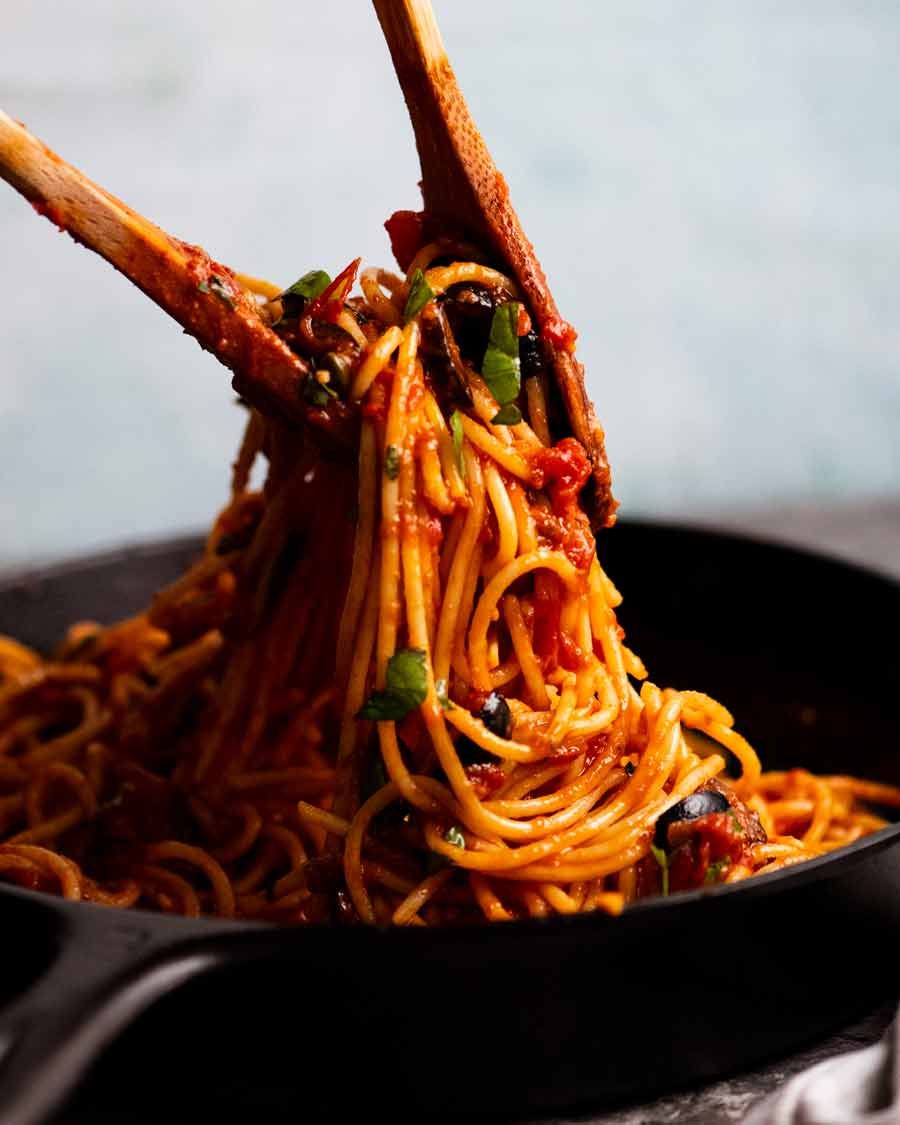
Pro tip: warm your pasta bowls
Pasta is a dish that is at its absolute best served hot and fresh. It is never the same reheated. It is also one of the rare dishes where I make the effort to warm serving bowls, to preserve the heat of the pasta when eating. I just pop them in a 70C / 160F oven to warm before I start cooking, or in the microwave for a minute before serving. It’s worth the small effort, especially in winter!

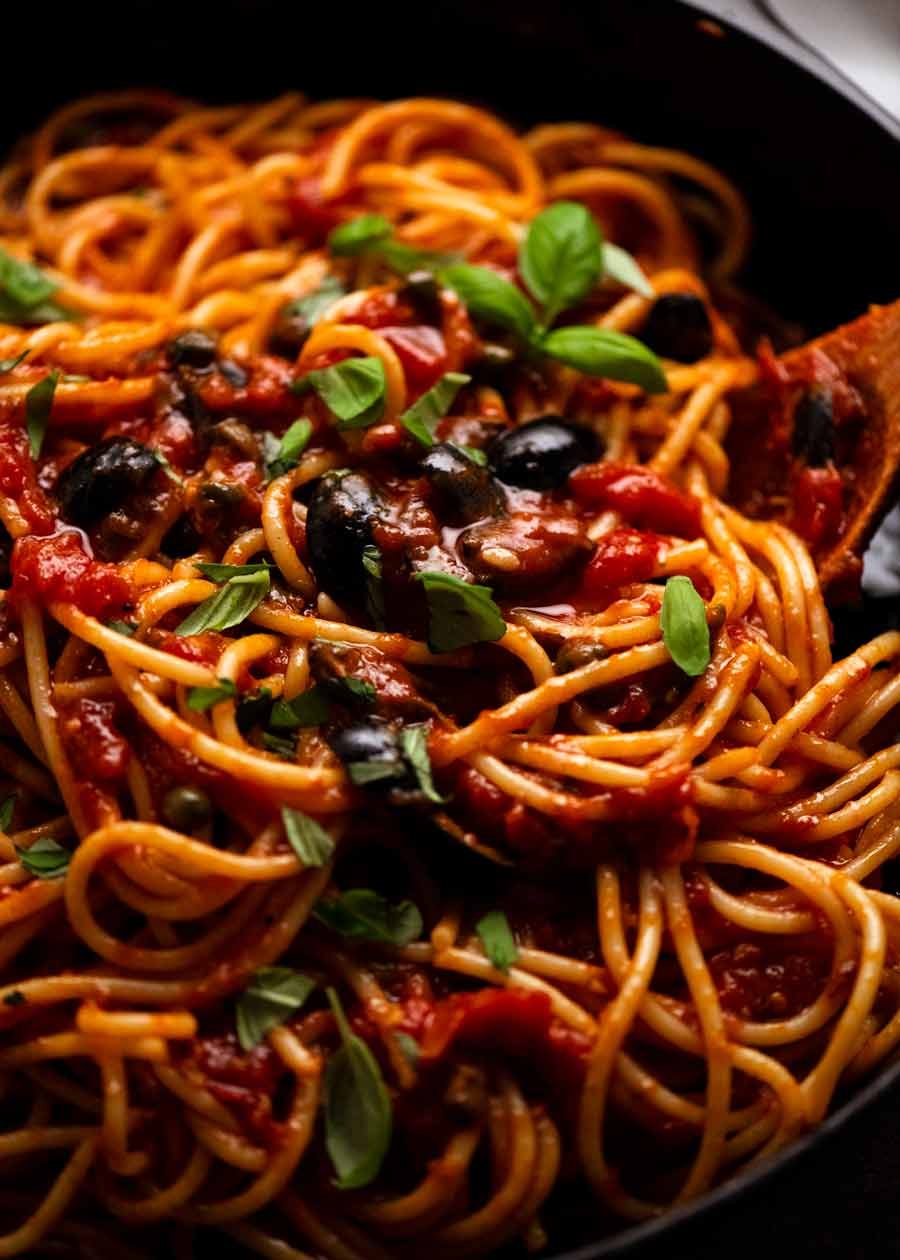
What to serve with Puttanesca pasta
Parmesan?
Puttanesca is traditionally not served with the typical shower of parmesan because it already has plenty of salt and savouriness from the flavour-packed ingredients. But I won’t stop you if that’s how you want to roll.
Having said that, if I don’t have fresh basil sometimes I use parmesan to compensate as a finishing touch (no it’s not the same thing at all, but I like to have a garnish).
Sides!
In my world, Puttanesca is planted firmly in the “emergency pantry meals” bucket so you won’t get a side salad if I make this for you. It’s also technically 95% vegetables anyway! 😉 However, if you’re after a super quick one that’s on-theme, Rocket with Shaved Parmesan fits the bill with a side of hot buttery garlic bread or focaccia (I’m very proud of this recipe, I hope you try it one day!).
Add a Tiramisu for dessert or Italian Almond cookies with coffee, and suddenly this humble “quick pantry dinner” has transformed into a full blown Italian dinner menu! – Nagi x
Complete your meal
Watch how to make it
Hungry for more? Subscribe to my newsletter and follow along on Facebook, Pinterest and Instagram for all of the latest updates.

Spaghetti alla Puttanesca
#wprm-recipe-rating-0 .wprm-rating-star.wprm-rating-star-full svg * { fill: #343434; }#wprm-recipe-rating-0 .wprm-rating-star.wprm-rating-star-33 svg * { fill: url(#wprm-recipe-rating-0-33); }#wprm-recipe-rating-0 .wprm-rating-star.wprm-rating-star-50 svg * { fill: url(#wprm-recipe-rating-0-50); }#wprm-recipe-rating-0 .wprm-rating-star.wprm-rating-star-66 svg * { fill: url(#wprm-recipe-rating-0-66); }linearGradient#wprm-recipe-rating-0-33 stop { stop-color: #343434; }linearGradient#wprm-recipe-rating-0-50 stop { stop-color: #343434; }linearGradient#wprm-recipe-rating-0-66 stop { stop-color: #343434; }
Ingredients
- 200g / 7ozspaghetti, or other long pasta
- 2tbspextra virgin olive oil, plus more for drizzling
- 2garlic cloves, finely minced (knife, not garlic press)
- 3anchovy fillets, finely minced (Note 1)
- 1/4cuppitted black olives, preferably in oil, quartered (Note 2)
- 1tbspcapers, drained (Note 3)
- 1/4tspchilli flakes(red pepper flakes)
- 400g / 14oz can crushed tomato(or hand crush whole canned tomatoes)
- 1/2cupwater
- 1tspfresh oregano, roughly chopped (sub 1/4 tsp dried)
- 1/8tspkosher / cooking salt(or 2 pinches table salt)
- 1/8tspblack pepper
- 1/4tspsugar, if needed (depends on tomato quality, Note 4)
- 2tbspfresh basil, roughly chopped (Note 6)
Instructions
-
Prepare: Bring a large pot of water to the boil, ready for the pasta. Warm serving bowls (I microwave 1 minute).
-
Cook garlic: Heat olive oil in a medium skillet over medium high heat. Add garlic and cook for 15 seconds until it starts turning golden.
-
Cook anchovies: Add anchovies, capers, olives and chilli flakes. Cook for 1 minute.
-
Tomato: Add tomato, then add the 1/2 cup of water into the can. Swirl around to rinse then pour into the skillet.
-
Simmer: Add oregano, salt and pepper. Stir, bring to simmer, then turn down to low and cook over medium heat for 10 minutes or until the tomato has broken down and created a sauce. Turn off stove when ready if not timed with cooked pasta.
-
Cook pasta: Meanwhile, add 2 teaspoons salt into the pot of water. Then add pasta and cook per packet directions.
-
Reserve pasta water (Note 5): Just before draining, scoop out a mugful of pasta cooking water and set aside. Then drain pasta in a colander.
-
Toss pasta: Immediately add pasta into sauce. Add 1/4 cup of pasta cooking water reserved from previous step (Note 5) then use 2 wooden spoons to toss the pasta, still on a low stove, for 1 minute or until the sauce is no longer in the skillet but rather clinging to the pasta strands (but still slick and slippery). If the pasta gets too dry, add more pasta cooking water and toss.
-
Serve: Immediately transfer into warmed bowls. Drizzle with olive oil, sprinkle with basil. Serve immediately!
Recipe Notes:
Nutrition Information:
Life of Dozer
His “look at me, I’m so good, puh-lease give me a treat” position. Sitting up straight, chest puffed out.
Who can resist? (Certainly not me!)

